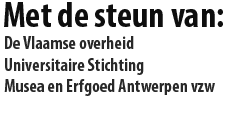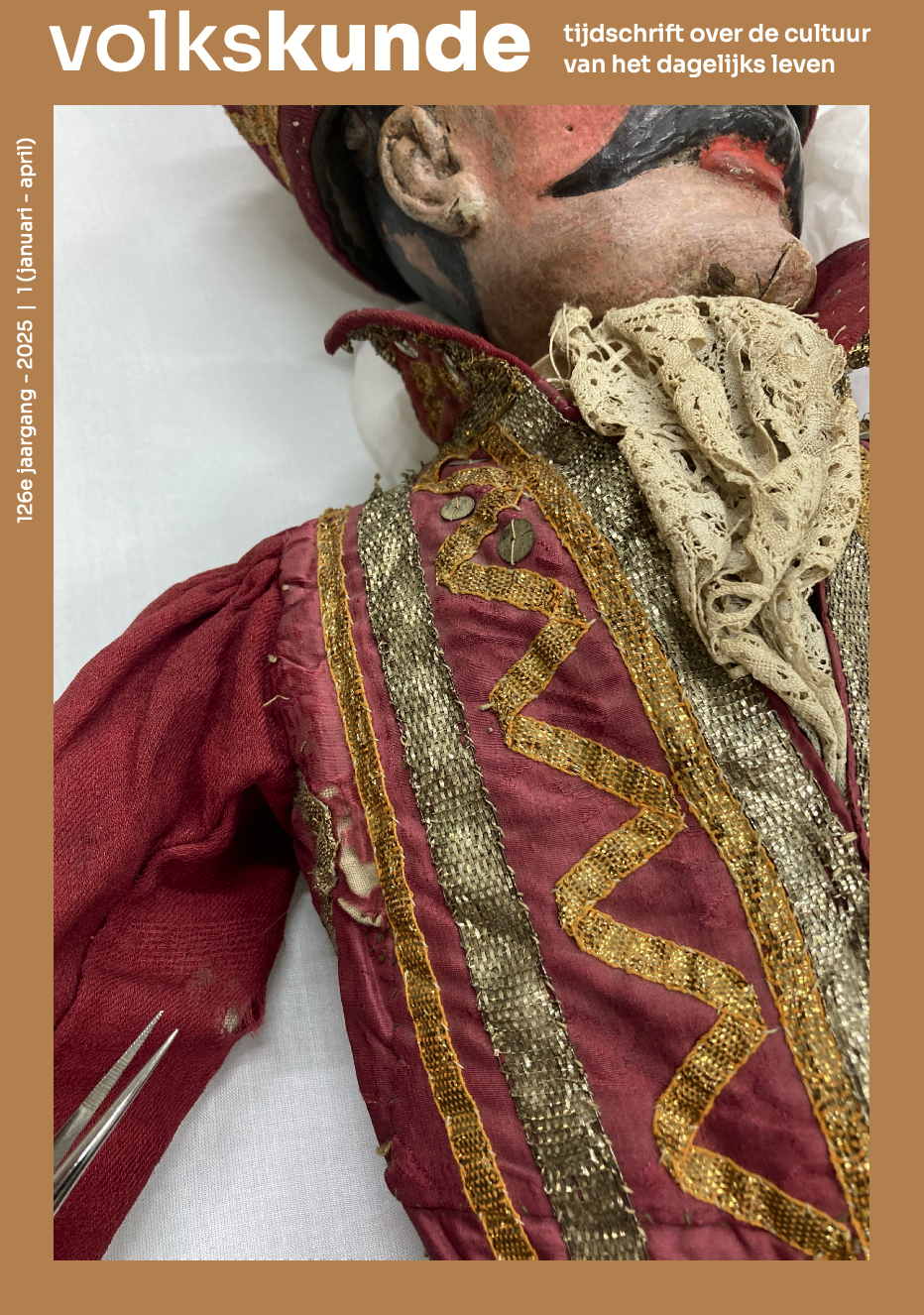- Luka Hendrickx – As Tough as Clay – Goose Pulling as a Cornerstone of Antwerp Polder Identity
- Paul Vandenbroeck – Of Unknown Heretics and Jheronimus Bosch – The so-called Tuin der Lusten (Garden of Earthly Delights) and an early 15th century Heterodox Cosmogony
- Griet Kockelkoren, Linda Wullus, Wies Stortelder & Ina Vanden Berghe – The Never-Ending Story … Tales of Play(ers), Forever Interwoven in the Material Biography of Marionettes
- Mark Bouma – The new drive of Dutroux. Disaster humour from the Titanic to COVID-19
- Mirte Triezenberg – The Timeless Pranks of Tijl Uilenspiegel – An analysis of Uilenspiegel and his pranks in the written and oral tradition through the years, and why he remains relevant today
- Björn Rzoska – The interview with my grandfather Paul Rumes viewed differently: how his testimony became a mental (and familial) reality that obscured the horror
Luka Hendrickx
As Tough as Clay – Goose Pulling as a Cornerstone of Antwerp Polder Identity
(Hard als klei – Gansrijden als hoeksteen van de Antwerpse Polderidentiteit)
Goose pulling, a game in which participants on horseback ride under a gallows to attempt the removal of a dead goose’s head, remains highly popular in six polder towns north of Antwerp, despite facing criticism and legal restrictions. This article examines this tradition—particularly the insistence on using a real goose—as a central element in the ongoing construction, affirmation, and expression of regional identity.
The case of the most recent goose pulling club, which explicitly frames the practice as a means to consolidate their rural “polder” identity, sheds light on this dynamic. This reflects a broader urban-rural identity polarization in Flanders, where the social capital of a rural identity increases as the spatial divide between urban and rural areas continues to blur. In the Polder region, this need for a distinct identity is especially pressing, rooted in the memory of the port of Antwerp’s expansion during the fifties and sixties of last century. This expansion led to the demolition of several towns and the loss of significant farmland.
This history shapes attitudes toward the city of Antwerp and informs how the Polder region perceives and portrays itself. The region’s memory culture highlights narratives of decline and loss as central to its identity, evident in discourses surrounding remnants of demolished towns (e.g., a church tower amidst an industrial site surrounded by containers) and the symbolic significance of “sand” and “clay”.
In this context, efforts to alter the tradition are framed as yet another “loss”, explicitly tied to the region’s recent history. This article explores various strategies to “protect” the tradition, including seeking heritage status and creatively circumventing regulations by freezing dead geese or hunting unprotected, invasive goose species
Paul VANDENBROECK
Of Unknown Heretics and Jheronimus Bosch – The so-called Tuin der Lusten (Garden of Earthly Delights) and an early 15th century Heterodox Cosmogony
(Van onbekende ketters en Jheronimus Bosch – De zogenaamde Tuin der Lusten en een vroegvijftiende-eeuwse heterodoxe cosmogonie)
The “alien” world of Hieronymus Bosch’s so-called Garden of Earthly Delights, which I prefer to call the Triptych of the Grail, is well known. It features impossible objects, non-existent plants, conglomerates of natural and artificial matter, and bizarre concretions of plants, animals, and humans. Most notably, it includes the five hallucinatory, phantasmagoric constructions in the background. Slightly similar but less elaborate semi-vegetal, semi-artificial entities occasionally appear in other paintings by Bosch, such as the Triptych of the Hermits (Venice), St. Jerome (Ghent), and two small representations of the Earthly Paradise (Vienna and Chicago).
There is no doubt that Bosch’s “world vision,” as depicted in the aforementioned triptych, does not correspond to the known world or to official late medieval worldviews. This view of Nature seems to have been one aspect of Bosch’s broader world concept. But did nothing similar exist before Bosch (c. 1450–1516)? Historians of art, culture, and religion have never identified similar “constructions” in earlier paintings or manuscript illuminations. However, one manuscript—famously associated with cryptology—contains not just a few but dozens of “Boschian” inventions: the so-called Voynich Manuscript (New Haven, Yale University, Beinecke Rare Book and Manuscript Library, Ms. 408).
Although its text is incomprehensible, the sequences of drawings unmistakably illustrate a non-orthodox worldview and cosmogony. This essay examines several correspondences between the manuscript’s drawings and Boschian inventions. While we cannot know whether Bosch ever saw this manuscript, it is clear that he was aware of heterodox imaginings concerning Nature and humanity. As Bosch was anything but a heretic, his Garden of Earthly Delights cannot have represented a “positive” view of humankind and Nature.
Griet Kockelkoren, Linda Wullus, Wies Stortelder & Ina Vanden Berghe
The Never-Ending Story … Tales of Play(ers), Forever Interwoven in the Material Biography of Marionettes
(Het oneindige verhaal … Verhalen van spel(ers) voor altijd verweven in de materiële biografie van marionetten)
This article focuses on two historical collections of rod puppets. The first collection is housed in the Art & History Museum in Brussels (KMKG-MRAH), while the second belongs to the still-active Marionette Theatre Toone in Brussels and is included in the inventory of Brussels’ intangible cultural heritage (ICH).
These collections are not only remarkable and unique heritage artifacts in their own right, but they also serve as witnesses to an intangible folk culture, carrying with them a wealth of narratives and memories embedded in their material biographies. These biographies encompass their active lives on and off stage, the performances and characters they embodied, the puppeteers and their practices, the makers and their craftsmanship, as well as their post-performance existence in both the museum and the theatre.
The study and conservation of these material objects, along with their intangible values and significance, required a tailored research and conservation approach. This, in turn, led to the development of a novel and specialized methodology within the Conservation-Restoration Studios for Textiles and Polychrome Wood Sculpture at the Royal Institute for Cultural Heritage (KIK-IRPA).
For conservation research, gaining a deeper understanding of the usage and performance practices of these puppets—and consequently, the traces of use reflected in their material biographies—was essential. To effectively gather, assess, and interpret this information, collaboration with conservators, conservation scientists, and imaging specialists within KIK-IRPA was crucial. Equally important was the involvement of archival, contextual, and ensemble researchers both within and beyond KIK-IRPA, as well as the invaluable insights of the contemporary puppetry community. Given their distinct preservation contexts, both collections required highly individualized research approaches.
This article presents and highlights the research and conservation efforts dedicated to these exceptional theatre puppets. While the objects were studied and conserved holistically through a synergistic and closely collaborative effort—primarily between the Conservation Studios for Textiles and Polychrome Wood Sculpture at KIK-IRPA—this article specifically focuses on the study of the textile components and collaborations with relevant heritage communities.
Mark Bouma
The new drive of Dutroux. Disaster humour from the Titanic to COVID-19
(De nieuwe oprit van Dutroux. Rampenhumor van Titanic tot corona)
A Good Joke or Bad Taste? Jokes about tragedies and disasters often provoke mixed reactions, yet the existence of this phenomenon is undeniable: disaster humour. Although many individuals perceive such jokes as premature, they tend to emerge shortly after a disaster occurs. For instance, it has been documented that within a day of the September 11 attacks or the tragic death of Diana Spencer, the first jokes had already begun circulating.
Numerous scholars have attempted to explain disaster humour, yet a comprehensive account addressing all aspects of this phenomenon remains elusive. Contrary to claims that disaster jokes constitute a contemporary development, historical evidence suggests that they are part of a long-standing tradition. From the Titanic shipwreck in 1912 to the recent COVID-19 pandemic, humour has consistently been used as a means of coping with tragedy.
The COVID-19 pandemic, however, introduced a notable shift in the nature of disaster humour. Whereas previous crises often gave rise to harsh and dark jokes, the humour during the recent pandemic remained comparatively mild. Although the precise reasons why individuals find certain disaster jokes amusing may never be fully understood, examining the underlying motivations for this form of humour remains a worthwhile endeavour. Consequently, it is essential to investigate the following questions: What constitutes disaster humour, and what compels individuals to create such jokes?
Mirte Triezenberg
The Timeless Pranks of Tijl Uilenspiegel – An analysis of Uilenspiegel and his pranks in the written and oral tradition through the years, and why he remains relevant today
(De tijdloze streken van Tijl Uilenspiegel – Een analyse van Uilenspiegel en zijn streken in de geschreven en de mondelinge traditie door de jaren heen, en waarom Uilenspiegel nog steeds relevant is)
Tijl Uilenspiegel is a legendary figure in Western European folklore. His tricks have inspired countless stories, passed down both orally and in writing for over 500 years. This essay explores how Uilenspiegel tales have evolved over time while preserving his defining traits: mischief, wit, humour, and defiance. These enduring qualities have allowed Uilenspiegel’s stories to remain relevant, adapting to different historical periods and cultural contexts. It is this combination of adaptability and timelessness that continues to captivate audiences today.
Björn Rzoska
The interview with my grandfather Paul Rumes viewed differently: how his testimony became a mental (and familial) reality that obscured the horror
(Het interview met mijn grootvader Paul Rumes anders bekeken: hoe zijn getuigenis een mentale (en familiale) realiteit werd die de gruwel verdoezelde)
Almost thirty years ago, Björn Rzoska interviewed his grandfather Paul Rumes about his collaborationist past. At the time, the author was convinced that it was a so-called testimonial witness account: a few years before his death, Paul Rumes provided a complete insight into what had driven him to enlist in the Waffen-SS. Consulting his criminal record in 2023 not only shattered that illusion, but it also prompted Rzoska to critically examine the interview from back then and the meanings of oral sources in general.


